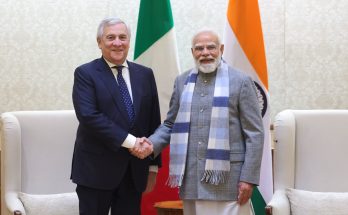
By Bibek Debroy
The SDGs are sustainable development goals, adopted as an agenda for 2030. They are so familiar that they need not be spelt out. As with the Millennium Development Goals (MDGs) earlier, there is a nested structure, with 17 broad goals imparted precision through 169 targets and further refined through indicators that are tracked. As adopted in September 2015, there are 232 indicators. To state the obvious, there are too many targets and indicators, working against focused attention by governments. But that structure is a given.
Covid knocked those aspirations for a six. There was Covid and consequent adverse impact not just on mortality, but morbidity, and health and education outcomes. Global growth and recovery are fragile. This has been accentuated by the Ukraine war. UN’s SDG Report for 2022 presents a sobering picture. 1 “Using the latest available data and estimates, it reveals that the 2030 Agenda for Sustainable Development is in grave jeopardy due to multiple, cascading and intersecting crises. COVID-19, climate change and conflict predominate.” Jeffrey Sachs and his colleagues do a parallel monitoring report and this also flags deflection of interest from SDGs. 2 “Yet, it is clear that these multiple and simultaneous crises have diverted policy attention and priorities away from medium and long-term goals such as the SDGs and the Paris Climate Agreement: a shift of focus towards short-term issues that threatens to slow down or even stall the adoption of ambitious and credible national and international plans but also squeezes available international funding for sustainable development.”
India, SDGs and Covid
Moving towards SDGs is in conformity with what India wishes to do in its pursuit of progress and development. “Sabka Saath Sabka Vikas Sabka Vishwas” and ease of living and ease of doing business have been the government’s template since May 2014, with the second Narendra Modi government a continuation of the first. The Covid pandemic caught India, like the rest of the world, unawares. It was an exogenous shock. At that time, it was the prevalent wisdom, articulated by many in the developed world, that India would go under. Millions would die. By any metric, especially when normalized for population, India has performed remarkably well.
1. The Sustainable Development Goals Report 2022, United Nations.
2. Sustainable Development Report 2022, From Crisis to Sustainable Development: the SDGs as Roadmap to 2030 and Beyond, Jeffrey D. Sachs, Guillaume Lafortune, Christian Kroll, Grayson Fuller, and Finn Woelm, Cambridge University Press, 2022.and mortality rates have been low. At that time, it was the prevalent wisdom that India would never be able to develop a vaccine of its own and, regardless, wouldn’t be able to vaccinate its population. Both propositions have been proved to be false. India has handled this externally-imposed disaster remarkably well, facilitated by the emphasis on a digital India and portability of welfare benefits.
In debates on fiscal policy, at that time, it was the recommended doctrine that,emerging from the lock-down and pandemic, India should increase public expenditure,meaning revenue expenditure, to stimulate the economy. With the exception of free food (Pradhan Mantri Garib Kalyan Anna Yojana), nothing of the sort was done. Union government increased capital expenditure, recognizing that the multiplier effects of capital expenditure are more than twice that on revenue expenditure, and did not throw fiscal caution to the winds. Therefore, so far as the macroeconomic fundamentals are concerned, India is one of the fastest growing economies in the world, this financial year, and also in the foreseeable future. Even on inflation, caused primarily by imported inflation, India has done remarkably well. Much of what was done was a continuation of policies pursued since May First, there has been an enabling framework for growth, development and
entrepreneurship to blossom and flourish. Second, there has been inclusion, interpreted as empowerment. A part of this is through provision of collective private goods – transport,education, health, electricity, gas, toilets, water, technology and financial products. This enables historically deprived and marginalized sections of society to become mainstreamed.
Economic Survey 2020-21 constructed a “bare necessities” index (BNI) to quantify and measure these improvements. 3 The remaining part was use of SECC to target subsidies toeligible beneficiaries, with DBT (direct benefit transfers) linked to bank accounts seeded with Aadhaar numbers. Other than government dashboards, these improvements are evident in third party audits and in responses to questions in National Family Health Survey (NFHS-5).Thus, it is no great surprise that UNDP’s 2022 report, using the multi-dimensional poverty index (MDPI), found that a large number of Indians had been raised above the poverty line. 4.Therefore, though all countries have deviated from SDGs, India is far better positioned than many. The afore-mentioned dashboard by Jeffrey Sachs et al also highlights this. One should state that the SDG indicators are adapted and modified by countries. For India, the Ministry of Statistics and Programme Implementation (MOSPI) has a national indicator framework. 5 What happens to India is an aggregate of what happens at the level of states. Niti Aayog scores states based on an SDG index. 6 It is easy to figure out which states are pulling India down – those below India’s performance. There is a need to prioritize public expenditure and focus it on areas that will deliver maximum outcomes. The aspirational districts programme is an example of such focus, launched in 2018 to target 112 .
3. Economic Survey 2020-21, Department of Economic Affairs, Ministry of Finance.
4. 2022 Global Multidimensional Poverty Index (MPI), UNDP, https://hdr.undp.org/content/2022-global-multidimensional-poverty-index-mpi#/indicies/MPI
5. https://mospi.gov.in/documents/213904/0/SDG+National+Indicator+Framework.pdf/6ea926e6-5346-d25c-d2a1-bd05883f3866?t=1594031858493
6. https://sdgindiaindex.niti.gov.in/#/
7. See, for example, “Delivering on the Sustainable Development Goals 2016-2030”, jointly with Bjorn Lomborg,EAC-PM Working Paper Series, EAC-PM/WP/02/2022, October 2022.relatively underdeveloped districts, and external validation shows there have been improvements.India and G-20 On 1 st December 2022, India took over the G-20 Presidency from Indonesia and the 18 th G-20 Heads of State and Government Summit will take place in September 2023 in Delhi. At the time of taking over of the G-20 Presidency, the Indian Prime Minister,Narendra Modi, wrote an article, carried in media, spelling India’s vision for G-20. 8 Parts of this should be quoted, because it sets out India’s objectives and vision. “The previous 17 Presidencies of the G20 delivered significant results – for ensuring macro-economic stability,rationalising international taxation, relieving debt-burden on countries, among many other outcomes. We will benefit from these achievements, and build further upon them.” One should remember that part of what happens throughout the year, is a carry-over of the agenda of the previous summits. “However, as India assumes this important mantle, I ask myself -can the G20 go further still? Can we catalyse a fundamental mindset shift, to benefit humanity as a whole?… One such tradition, popular in India, sees all living beings, and even inanimate things, as composed of the same five basic elements – the panch tatva of earth,water, fire, air and space. Harmony among these elements – within us and between us – is essential for our physical, social and environmental well-being.
8.India G20 Presidency will work to promote this universal sense of one-ness. Hence our theme – One Earth, One Family, One Future.Today, the greatest challenges we face – climate change, terrorism, and pandemics – can be solved not by fighting each other, but only by acting together.Fortunately, today technology also gives us the means to address problems on a humanity-wide scale. The massive virtual worlds that we inhabit today demonstrate the scalability of digital technologies.” That’s what the SDGs are about. To quote further, on the Indian successes outlined in Section 2, “We have tried to make national development not an exercise in top-down governance, but rather a citizen-led ‘people movement’.
9. We have leveraged technology to create digital public goods that are open, inclusive and inter-operable. These have delivered revolutionary progress in fields as varied as social protection, financial inclusion, and electronic payments. For all these reasons,India’s experiences can provide insights for possible global solutions. During our G20 Presidency, we shall present India's experiences, learnings and models as possible templates for others, particularly the developing world. Our G20 priorities will be shaped in consultation with not just our G20 partners, but also our fellow-travellers in the global South,whose voice often goes unheard.There are several parallel processes under G-20. There are the Sherpa and Finance Tracks, facilitated through Working Groups. There are several Engagement Groups. There will be official G-20 meetings, not only in Delhi, but in various cities. This is symptomatic
10. https://www.narendramodi.in/today-india-commences-its-g20-presidency.
11. On 15 th August 2021, the PM expanded 'Sabka Saath, Sabka Vikas, Sabka Vishwas’ to include ‘Sabka Prayas'a core element in many schemes and programmes,of the inclusion that the Indian Presidency brings into the G-20 process. Yes, there will be a showcasing of India’s culture and heritage and achievements. Those achievements are steps towards the SDGs, for India, and for the world.
Author Profile
- India Writes Network (www.indiawrites.org) is an emerging think tank and a media-publishing company focused on international affairs & the India Story. Centre for Global India Insights is the research arm of India Writes Network. To subscribe to India and the World, write to editor@indiawrites.org. A venture of TGII Media Private Limited, a leading media, publishing and consultancy company, IWN has carved a niche for balanced and exhaustive reporting and analysis of international affairs. Eminent personalities, politicians, diplomats, authors, strategy gurus and news-makers have contributed to India Writes Network, as also “India and the World,” a magazine focused on global affairs.
Latest entries
 India and the WorldNovember 26, 2025G20@20: Africa’s Moment – The Once and Future World Order
India and the WorldNovember 26, 2025G20@20: Africa’s Moment – The Once and Future World Order DiplomacyOctober 4, 2025UNGA Resolution 2758 Must Not Be Distorted, One-China Principle Brooks No Challenge
DiplomacyOctober 4, 2025UNGA Resolution 2758 Must Not Be Distorted, One-China Principle Brooks No Challenge India and the WorldJuly 26, 2025MPs, diplomats laud Operation Sindoor, call for national unity to combat Pakistan-sponsored terror
India and the WorldJuly 26, 2025MPs, diplomats laud Operation Sindoor, call for national unity to combat Pakistan-sponsored terror India and the WorldJuly 25, 2025When Fire Ends, Diplomacy Begins
India and the WorldJuly 25, 2025When Fire Ends, Diplomacy Begins







